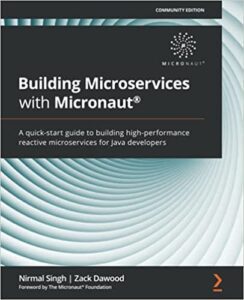Nirmal Singh is the author of Building Microservices with Micronaut®; we got the chance to sit down with him and find out more about his experience of writing with Packt.
Q: What are your specialist tech areas?
Nirmal: I have worn quite a few hats while working in various techno-functional roles. My specialties include full-stack software development, Java, Spring Boot, Spring Batch, JPA, Angular, Bootstrap, Jasmine/Karma, Oracle, SQL Server, Postgres, Neo4j, MongoDB, Liquibase, Google Compute, AWS, Azure, Docker, Kubernetes, Elasticsearch, Logstash, Kibana, Apache Kafka, Prometheus, Grafana, Microservices, RESTful Web Services, SOAP, and service-oriented architecture.
Q: How did you become an author for Packt? Tell us about your journey. What was your motivation for writing this book?
Nirmal: For the longest time in my career, I’ve engaged in server programming. I began my web services journey with SOAP, and recent advancements in RESTful and microservices have turned a new page. With a breadth of experience in web services, I was motivated to explore this freshly brewed framework (Micronaut®) for microservices development, and my learning experiences moved me to share this knowledge with the DEV community. This fruitful engagement with Packt started with watercooler discussions with my co-author Zack Dawood that resulted in actual book shaping. It’s been a great learning experience, and we’re glad to share this journey with everyone.
Q: What kind of research did you do, and how long did you spend researching before beginning the book?
Nirmal: I began reading about the Micronaut framework from its early nimble development days in late 2018. Their USP of cutting startup times and runtime resource footprint echoed with me. Before the book, my experiments and learnings with the Micronaut framework were ad hoc. For book-writing purposes, we drafted a clear plan mimicking the typical software development life events – development, testing, deployment, and maintenance. For aspects of each of these main events, we explored the Micronaut framework resources. We performed POCs and spikes for each aspect along with exploring multiple ways; e.g., for securing services we covered all the different ways, i.e., session, JWT, and OAuth. Post code experiments, I would jot down the learnings and we would chalk out chapter or section plans.
Q: Did you face any challenges during the writing process? How did you overcome them?
Nirmal: Writer’s block is real and I’ve faced this a few times. Also, it’s unusual for a developer like me to paraphrase a learning or a coding aspect. In some earlier chapters, I struggled with putting my learning experiences into words. But as I progressed with writing, I felt more comfortable.
Q: What’s your take on the technologies discussed in the book? Where do you see these technologies heading in the future?
Nirmal: The tech stack covered in the book is relatively advanced, and instead of superficially covering the technologies we worked on a real-world application. As we progressed with the app’s life cycle events, some components of the technology got adopted organically in the process. Microservice adoption is happening at a large scale in the industry now. Even the most risk-averse industry sectors have begun adopting the microservices architecture. This brownfield adoption is moving to greenfield adoption soon.
Q: Why should readers choose this book over others already on the market? How would you differentiate your book from its competition?
Nirmal: Learning resources on the Micronaut framework are pretty scarce, and the most reliable sources are official documentation. A recipe book was missing, and our book Building Microservices with Micronaut® bridged this gap and fulfilled a much-needed requirement of the DEV community.
Q. What are the key takeaways you want readers to come away from the book with?
Nirmal: The book essentially shows you how to work on different aspects of microservices using the Micronaut framework: what is the toolkit available within the Micronaut framework or microservice ecosystem for developing, testing, deploying, and maintaining a microservice application.
Q. What advice would you give to readers learning tech? Do you have any top tips?
Nirmal: We have structured this book for all levels (beginner, intermediate, and expert). Start by taking baby steps, and as you get to grips with the Micronaut framework start working on your coding chores. Coding chores/experiments will help you to apply your learnings and retain the knowledge you’ve gained for a longer time. Don’t stress yourself if something is not working as expected, take a break and try it again.
Q. Do you have a blog that readers can follow?
Nirmal: I used to post frequently on https://itsnirmal.wordpress.com/, but for the past few years I’ve been less active.
Q. Can you share any blogs, websites and forums to help readers gain a holistic view of the tech they are learning?
Nirmal: The Micronaut framework has helpful learning resources at https://micronaut.io/.
Q. How would you describe your author journey with Packt? Would you recommend Packt to aspiring authors?
Nirmal: Our journey with Packt has been blissful. The Packt team has been really supportive and encouraging throughout. A big thank you to the entire crew, and yes, a note to up-and-coming authors, Packt is the best crew you can ask for!
Q. What are your favorite tech journals? How do you keep yourself up to date on tech?
Nirmal: I follow a few virtual resources. I am a regular reader of https://martinfowler.com/, https://www.baeldung.com/, https://blogs.oracle.com/java/, and https://vladmihalcea.com/.
Q. How did you organize, plan, and prioritize your work and write the book?
Nirmal: The pandemic has impacted all of us and our work routines. I too was impacted both by my work and book commitments. From the get-go, the Packt team helped draft a schedule for experimenting, drafting, and finishing the chapters. Often in my coding chores, I would have to work late nights or weekends and my wife has been really supportive. If I would procrastinate, she would say I will sit with you till you finish the chapter. On organizing the work – we followed a routine software life cycle so most of the daily work rhythm reflects in the book work too.
Q. What is that one writing tip that you found most crucial and would like to share with aspiring authors?
Nirmal: Do enough signposting to keep your readers engaged.









